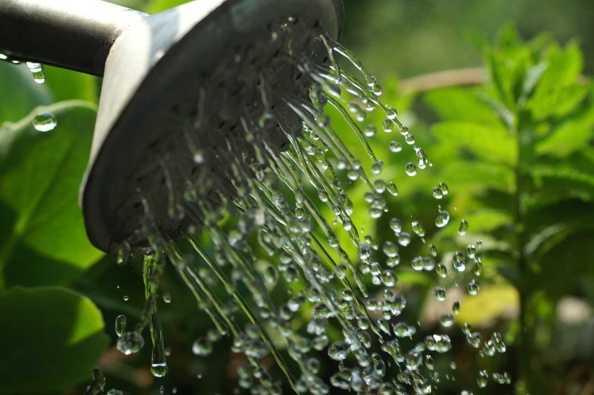After a great summer with scorching temps on the Port Hills, the plants started to suffer a wee bit – away from home for a week or more makes most gardeners a bit anxious. Plants dried out very quickly.
How to Water?
Never been a fan of sprinklers. I try to keep my leaves dry as much as possible; wet leaves often give fungal spores the opportunity to settle on the plant, causing leaf-spots, rots, downy mildew, and powdery mildew.
Try to water the root zone of a plant, by depositing the water —gently— on the soil. A fierce jet of water can clog the porosity of the soil (not so good either!), so a nice shower-setting of your hose handpiece is perfect.
Evening or Morning?
It doesn’t really matter a lot, I think. The water cools the soil remarkably and, in the morning, (when it’s cooler) most of the water will actually penetrate the soil. In the evening (with warmer temperatures) a proportion of the water will evaporate, become a “cloud” of H2O gas and meet its mates, somewhere high up in the sky. In other words, it doesn’t do the plants much good.
But watering in the middle of the day makes a huge percentage of the water disappear into the stratosphere.
In my tunnel house (Tomatoes, Cucumbers, Capsicums) I prefer an evening watering to moisten the soil…. Followed by a liquid fertiliser (seafood Soup / Seaweed Tea) a few hours later when the soil is cooler, and the plants are in the mood for a liquid “meal”
Established shrubs and trees?
Most Nature Nerds that go walking will see in dry summers how established trees show severe signs of dehydration or wilting. Even without any rain those leaves will often look a lot better in the evening. Wilting is simply a strategy to shut off the leaves’ stomata to save the moisture escaping from these openings in the heat of the day.
This wilting can go on for weeks, sometimes.
A thoroughly good soak (hours and hours of watering) can re-set the water deficit in the soil. This deep watering is far more beneficial to soil and shrubs/trees than daily “piddle-waterings”
Over-watering?
As mentioned, a few months ago: to get trees and shrubs acclimatised to the drought, don’t “Over-Water” them. Let the search for water by getting the roots to grow deeper and further away from the main trunk/stem. Build Resilience!!
I reckon that UNDER-WATERING is a great way to train your perennials.
Regular droughts? Which plants are suited for water-stressed areas?
Think Mediterranean species that often don’t get much during the 5 months of summer in Spain and Morocco and Italia. Often plants with blue-ish or white-ish colours or with thick hairs on the leaves (that stop water loss). Euphorbias, Echiums, Watsonias, cacti, succulents, phlomis, Jerusalem sage, rosemary, lambs ear, etc etc.
Plants that can NEVER dry out.
Ferns have got a different vascular system in their stems and fronds; these bundles are not as strong and lignine-supported as other “Vascular plants”; So when a fern gets too dry, its bundles simply shrivel up and irreversibly collapse.
I warned you!!
Take your Radio, Podcasts and Music with you










